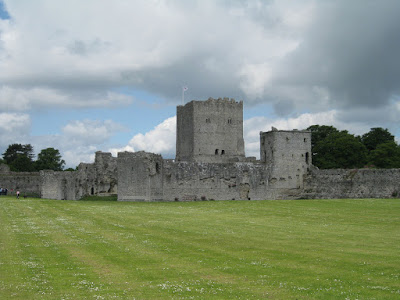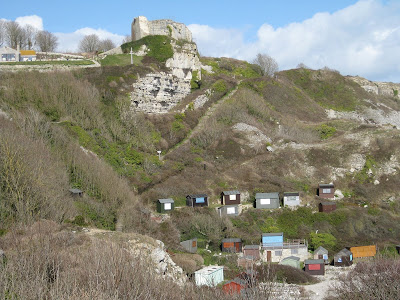 (Click photos to enlarge).
(Click photos to enlarge).The dolmem - or cromlech - of Gwal Y Filiast is quite well hidden away just outside of the small village of Llanglydwen in Carmarthenshire. To reach it you have to take a walk down a muddy track for about 10 minutes or so and take a turn into the woods.
 It's very easy to get yourself lost whilst looking for this site. My father and I tried finding it one day during the Christmas holidays and ended up going too far and following the river and surrounding woodland for hours. We still managed to take a wrong turning today when we visited, although we knew the rough direction this time and soon got back on track.
It's very easy to get yourself lost whilst looking for this site. My father and I tried finding it one day during the Christmas holidays and ended up going too far and following the river and surrounding woodland for hours. We still managed to take a wrong turning today when we visited, although we knew the rough direction this time and soon got back on track. Gwal Y Filiast - the name translates as Lair of the She-Wolf or Lair of the Grey Hound Bitch (not greyhound but grey hound - literally a hound that is grey - a wolf) - seems unusual for such a burial chamber being located in this setting beneath the trees.
Gwal Y Filiast - the name translates as Lair of the She-Wolf or Lair of the Grey Hound Bitch (not greyhound but grey hound - literally a hound that is grey - a wolf) - seems unusual for such a burial chamber being located in this setting beneath the trees. The dolmen is at the epicentre of a ring a beech trees, while several other stones which may once have been part of the greater structure are scattered around the site. The dolmen itself consists of a huge capstone - easily 10 feet in length and 3 to 4 feet in thickness - balanced on four uprights, and there are a pair of smaller stones set in the ground at one end.
The dolmen is at the epicentre of a ring a beech trees, while several other stones which may once have been part of the greater structure are scattered around the site. The dolmen itself consists of a huge capstone - easily 10 feet in length and 3 to 4 feet in thickness - balanced on four uprights, and there are a pair of smaller stones set in the ground at one end. This is a really atmospheric site, which is in no doubt enhanced by its surroundings on the wooded slope above the river Taf. It is a little off the beaten track and is unlikely to be visited by casual tourists, who would be far more likely to head for somewhere better known in the general area such as Pentre Ifan. I think they are missing out! Remember to consult a map if you want to visit and wear walking boots or wellies!
This is a really atmospheric site, which is in no doubt enhanced by its surroundings on the wooded slope above the river Taf. It is a little off the beaten track and is unlikely to be visited by casual tourists, who would be far more likely to head for somewhere better known in the general area such as Pentre Ifan. I think they are missing out! Remember to consult a map if you want to visit and wear walking boots or wellies! Date visited: 31 May 2009.
Date visited: 31 May 2009.See also: Gwal Y Filiast on The Megalithic Portal
Gwal Y Filiast on The Modern Antiquarian












































